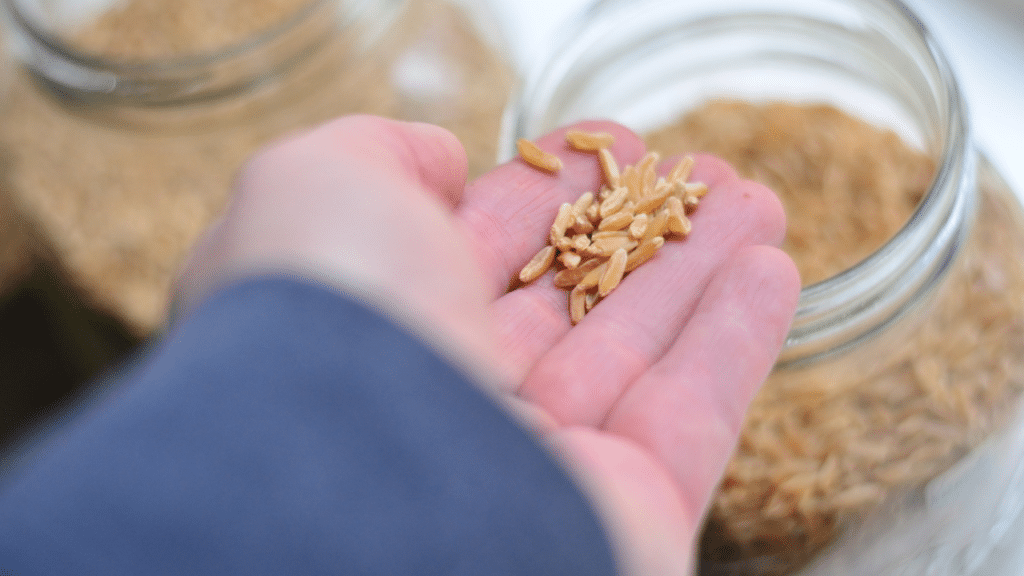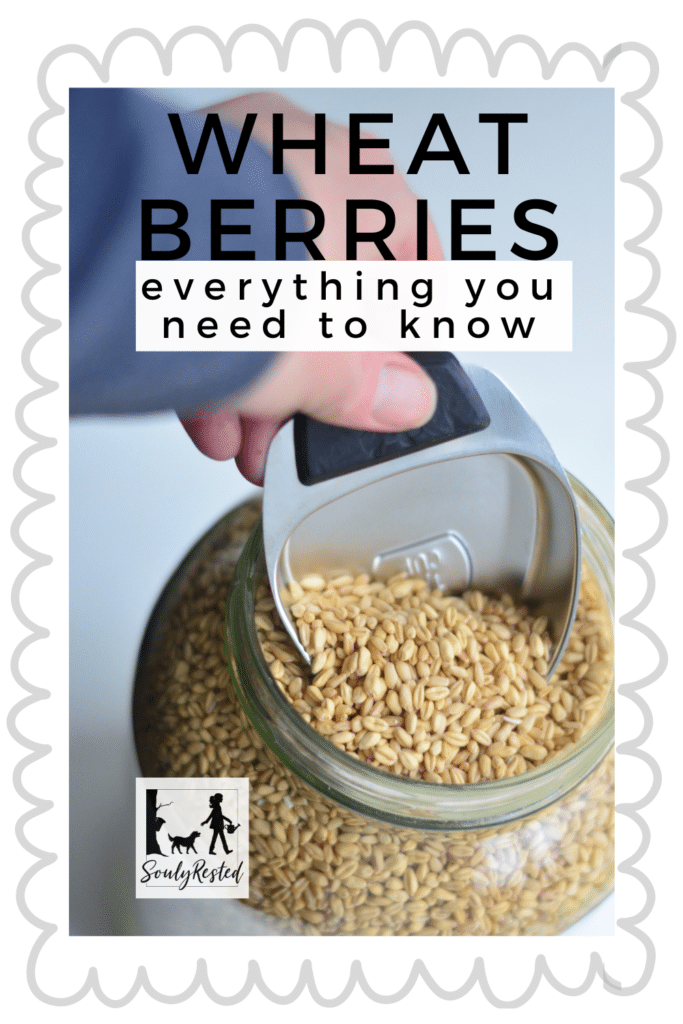Last Updated on May 13, 2024 by Michelle
A decade ago I had no idea what a wheat berry was.
For all I knew it was an exotic fruit.
Fast forward to today and I’m writing an ultimate guide to wheat berries, I no longer buy flour from the store, and I bake a lot of my family’s bread products from scratch with fresh flour I mill from whole wheat berries.
Sidenote: The Classic Nutrimill Grain Mill is currently $50 off. Use code SOULYRESTED to save another $20! Go here to see everything that’s on sale, including the Bosch mixer bundles
Funny how life goes. But I’m glad it’s always full of great surprises.
Fresh flour is definitely one of them. Dive into my free e-course about fresh flour here.
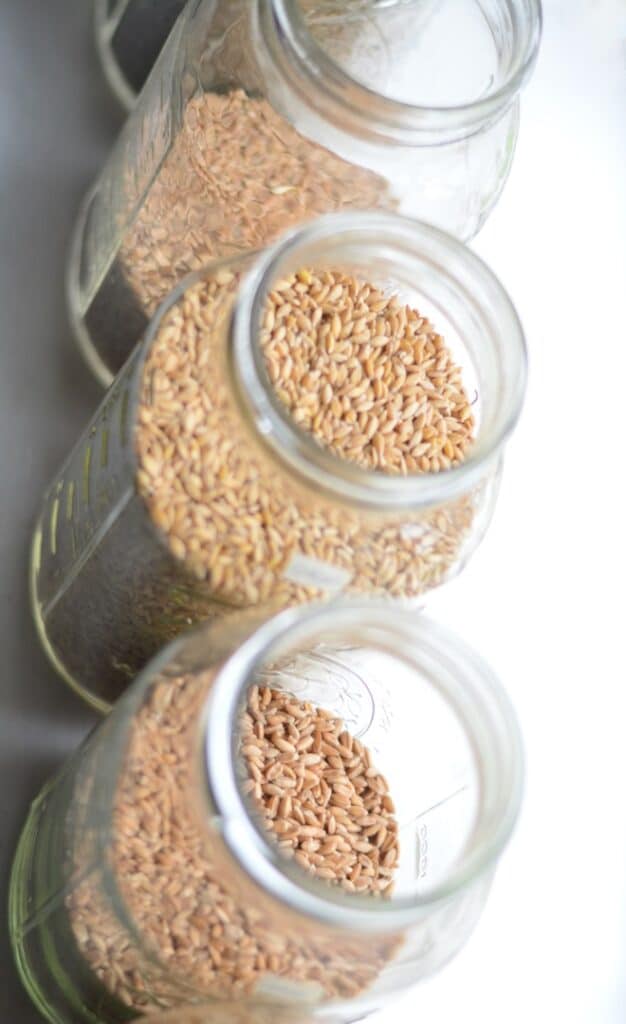
What are wheat berries?
So what are wheat berries?
Wheat berries are the whole kernels of a wheat plant, with the husk removed. If you walked into a wheat field, shook the stalk until the kernels fell into your hand, and removed the husks that surround the wheat berries, you’d have a handful of whole wheat berries.
Officially, a tiny wheat berry is actually made up of 3 parts (more about why each part is important below):
- The endosperm makes up roughly 80%.
- The germ makes up about 5%.
- The bran equals roughly 15%.
Is there another name for wheat berries?
Are wheat berries a superfood?
Every single wheat berry is a superfood package, made up of three parts:
- The endosperm is mostly starch, with a small amount of protein and a little bit of vitamins and minerals.
- The germ is essentially the “embryo” of the wheat berry, meaning it’s the part that can sprout into a plant under the right conditions. The germ is rich in B vitamins, high in protein, full of many minerals, and contains healthy fats.
- The bran is the outer “skin” of the wheat berry, and it’s extremely high in fiber, other vitamins, and loaded with antioxidants. The bran makes up about 14% of the wheat berry.
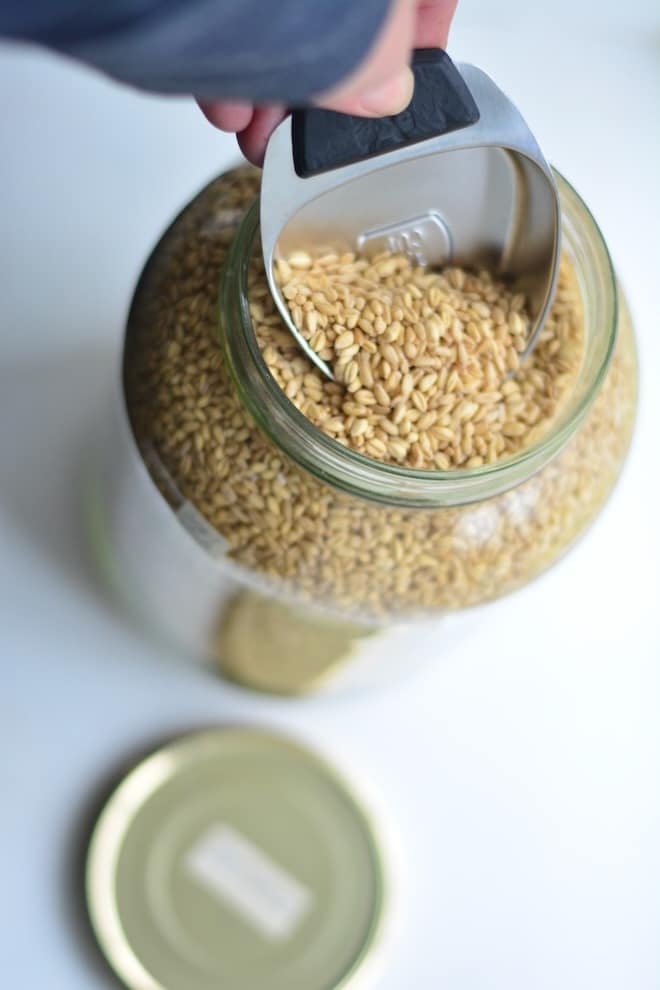
What are wheat berries good for?
My favorite use for wheat berries is grinding them into nutritious flour. For the full story, I explain here why I started milling my own flour. But wheat berries are also great cooked whole and used like rice, sprouted and added to salads and sandwiches, puffed and used as cereal, added to soups or stews in place of barley or rice, or even flaked like oats and used in oatmeal, breads, or granola bars.
There are basically endless uses for wheat berries!
Are wheat berries healthier than rice?
Can you eat wheat berries like rice?
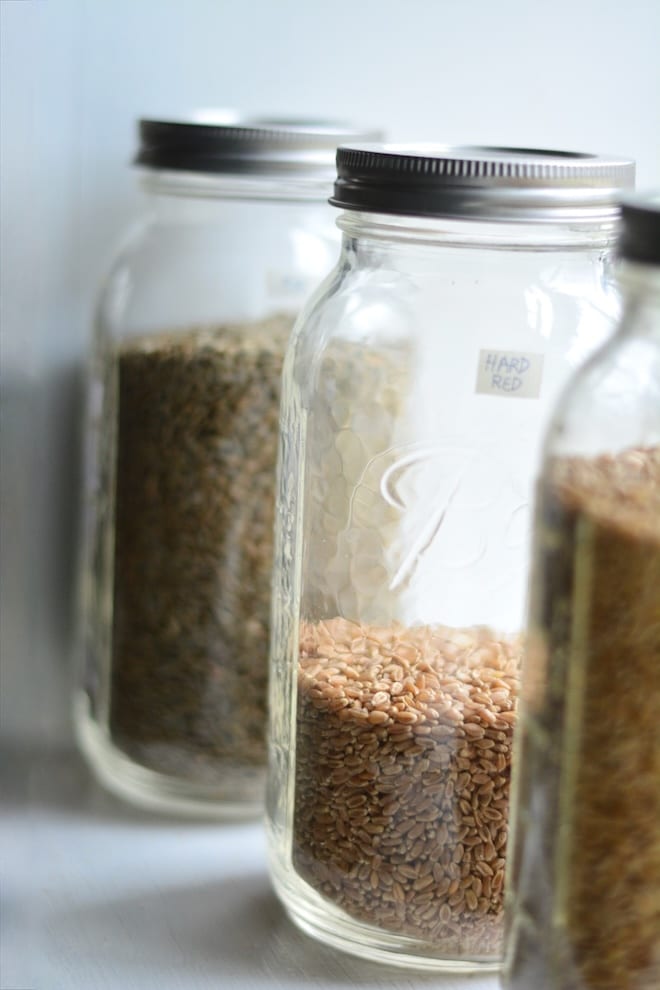
Can I eat wheat berries every day?
Given that wheat berries are powerhouses for vitamins, minerals, antioxidants, healthy fats, and protein, not only are you able to eat wheat berries every day, but your body would thank you!
It is worth noting that some folks can feel bloated or get a stomach ache if they eat too many whole wheat products in a day if their body isn’t used to them.
As with anything, start slowly and ease your body into eating a diet packed with whole grains.
I know my family and I feel great when we focus on adding lots of whole grains into our daily diet.
Do wheat berries go bad?
As long as wheat berries are unmilled and stored in a cool, dark, airtight place, they can last 30 years or longer. They really don’t ever go bad.
How long do wheat berries last?
That bran we were talking about earlier? It creates an amazing outer coating, which protects the more sensitive parts inside the berry (the endosperm and the germ). The bran keeps the wheat from going bad.
Once wheat is milled, that’s a whole different story. Fresh milled flour is more nutritious the sooner you use it after milling it. Once the outer bran is shattered (milled), the inside of the wheat is exposed to air and oxidizes, quickly loosing nutrients.
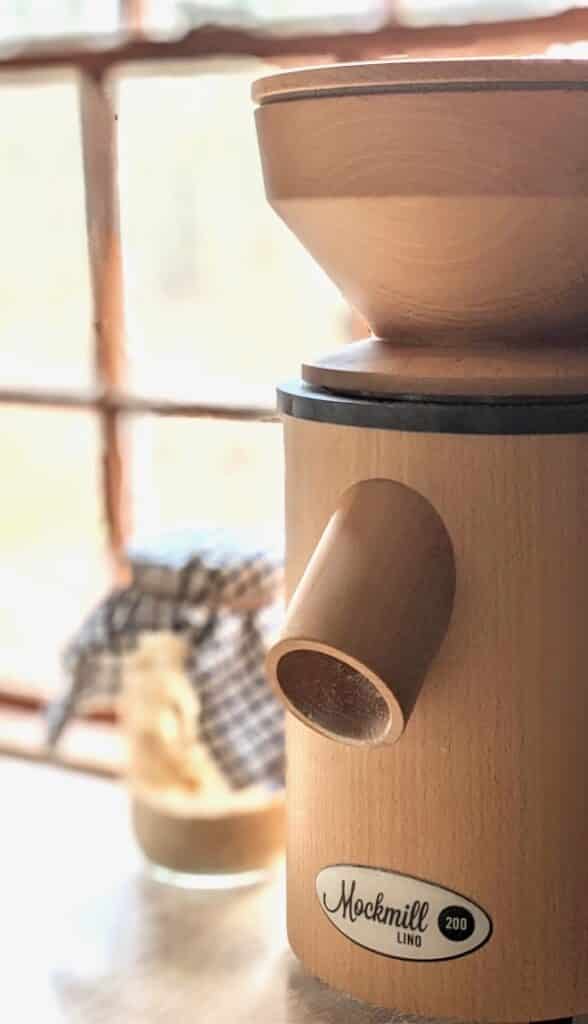
What wheat berries should I use to make flour?
Pretty much any type of wheat berry can be ground into flour, but you’ll want to use the right kinds of wheat for certain baking projects. There are three main choices you have when purchasing wheat berries. Keep reading for the full explanation.
What’s the difference between the different wheat berries?
This is maybe the most common question I get about fresh milled flour… and I get it… I understand why it trips people up when they are trying to decide what wheat berries to grind for what kind of baked good. There are essentially 3 variables you want to understand if you want to choose a perfect wheat berry for each job.
Understand if you should use a hard or soft wheat berry, a spring or winter variety, and red or white berries. Let’s break each of these variables down right now:
1) Hard wheat berries vs. soft wheat berries
Hard wheats have higher gluten potential than soft wheats.
Gluten is the protein that you want to develop in bread doughs to create soft, light loaves (but, sidenote, you don’t want to develop gluten in baked goods like cakes or muffins or they’ll be gummy).
Hard wheat berries should be used for:
- breads,
- yeast rolls,
- soft pretzels &
- artisan breads
Essentially, if you’re making something with yeast (or with a sourdough starter that you’re using in place of yeast), you’ll want to use hard wheat varieties.
Develop that gluten, friend!
If, on the other hand, you’re making something that doesn’t have yeast, and you want it to be soft, light, and fluffy, you’ll want to use softer wheat varieties.
Soft wheat berries should be used for:
- muffins,
- cakes,
- brownies,
- pastries,
- crackers &
- other baked goods
Generally, for breads and things using yeast to rise, grab hard wheat berries. For pastries and other tender baked goods, use soft wheat.
Pro tip: if you’re baking and unsure whether to use soft or hard wheat, a great go-to is a 50/50 blend of white hard and white soft wheat, which creates an all-purpose flour substitute.
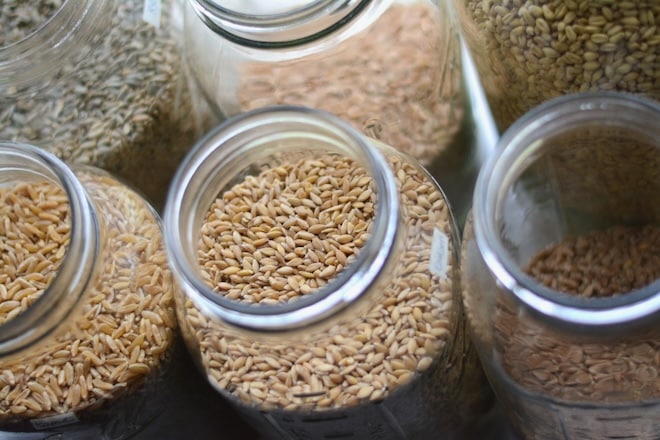
2) Spring wheat berries vs. winter wheat berries
This one simply comes down to how the wheat is grown. Winter wheat is sown in the fall, grows (slowly!) through the winter and is harvested in the spring of the following year. Spring wheat, on the other hand, is sown in the spring, grows through the summer, and is harvested that same year, in the fall.
The confusing thing here is that spring wheat technically has higher gluten potential than winter wheat does, yet most bread bakers prefer winter wheat. This is because the gluten produced using spring wheat will be more tender, touchy and easily broken, whereas the gluten developed using winter wheat will be stronger and better able to withstand mixing and being handled.
Generally, for breads and yeasted things that you want to develop strong gluten, grab winter wheat berries. For things you’d like more soft and tender that don’t use yeast, use spring wheat.
Having said all of this, I should clarify two things:
- The difference between spring and winter berries is minimal, so you really don’t need to stress over this too much.
- Your supplier will, most likely, only disclose this variable if you’re dealing with a local farmer or a high-end, fancy distributer.
3) Red wheat berries vs. white wheat berries
Most folks explain the difference between red and white wheat berries as saying that red wheat has a stronger flavor and white has a more mild flavor. But I personally don’t really love that explanation, because both taste amazing, just in different ways.
Another misconception is that red wheat is healthier than white wheat, but they’re nutritionally very similar.
Red wheat berries do tend to have a more “wheat-y” taste, due to being higher in tannins than white wheat, but many varieties of red wheat are more accessible for many folks and are often a good bit cheaper. And, in my experience, red and white wheats taste very similar.
In fact, I prefer the deeper flavor of red wheat in some recipes. Sometimes the flavor of white wheat comes across is too bland for me.
In my opinion, you can’t go wrong with either red or white wheat varieties.
If you’re just starting out with wheat berries and milling your own flour, I always recommend you go ahead and start with white wheat to give your tastebuds more time to adjust to the flavors of whole wheat. But once you’re in love with the rich, full-bodied flavor of whole wheat products, I wouldn’t be surprised if you find yourself favoring red wheat over white for it’s more robust flavor profile.
Generally, choose red wheat varieties when you’d like strong, robust flavor of the wheat to shine, and white wheat when you’d like the wheat flavor a bit more mild.
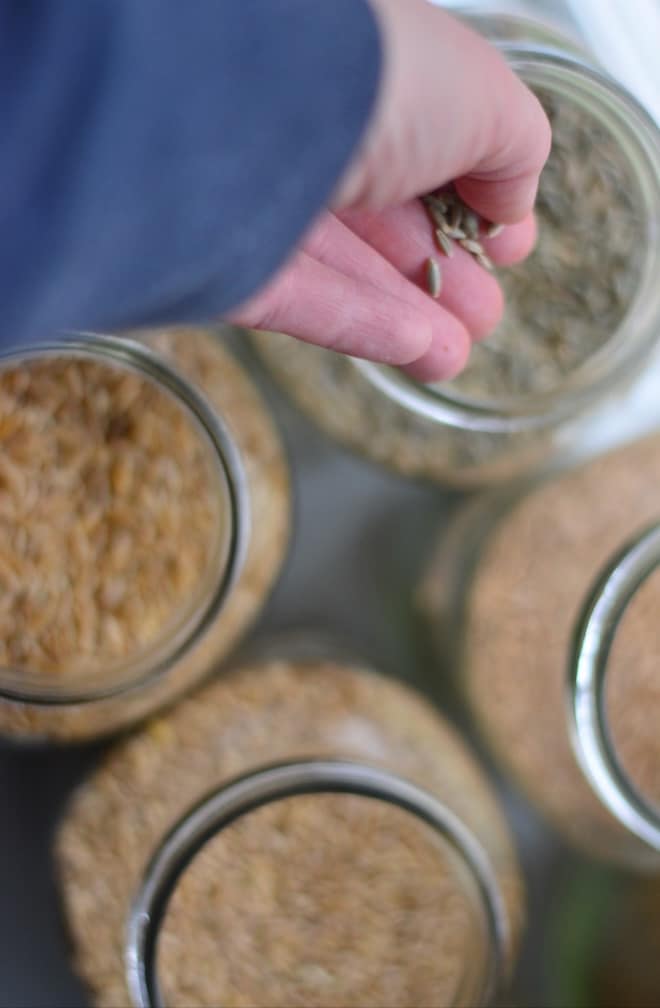
How and when to use ancient grains
Now that we’ve covered hard vs. soft wheats, spring vs. winter, and red vs. white, let’s talk about ancient grains. In my opinion, they’re in a category of their own and deserve as much love as the other guys.
For me personally, the ancient grains that I keep within reach are:
- spelt
- einkorn
- barley
- sorghum &
- kamut
Each ancient grain needs to be treated a little differently.
Spelt, einkorn, and kamut are great for breads. But keep in mind that they tend to be lower in gluten than modern grain varieties. I often add vital wheat gluten to my bread when I’m using any of these grains to help my bread rise better. (Find my favorite vital wheat gluten here.) But all three of these are also great in any baked goods as well as bread.
Barley and sorghum are great for baked goods. Sorghum has a bit of a sweet, graham-like flavor that’s great in cookies or homemade graham crackers. Barley is very mild and amazing in any baked good where you want the flavors of the cookies to shine more than the flour. Neither of these are good in bread products that require yeast.
Can you buy wheat berries at the grocery store?
I personally have never seen wheat berries at the grocery store, and if I did ever come across them I assume they would only be available in small bags. If you’re hoping to grind all your own flour, buying wheat berries in bulk is truly the only way to go.
I personally purchase all of my wheat berries, ancient grains, and alternative flour options (like dent corn and chickpeas) from one source. Azure Standard. Find out more about Azure right here.
How to turn wheat berries into flour
If you’re just getting started on your fresh flour journey, using a high powered blender or food processor can work for a while. But I honestly don’t recommend it. My fear is that the coarse flour and the headache of grinding it will both deter someone from ever truly pursuing making their own flour.
If you’re going to continue grinding wheat berries into flour, you’ll really want a great home mill. My ultimate guide to choosing a grain mill can help you decide which one is best for you.
But in the end, turning whole wheat berries into flour is as simple as grinding them! And, just like that, you have the most nutritious flour in the world at your fingertips.
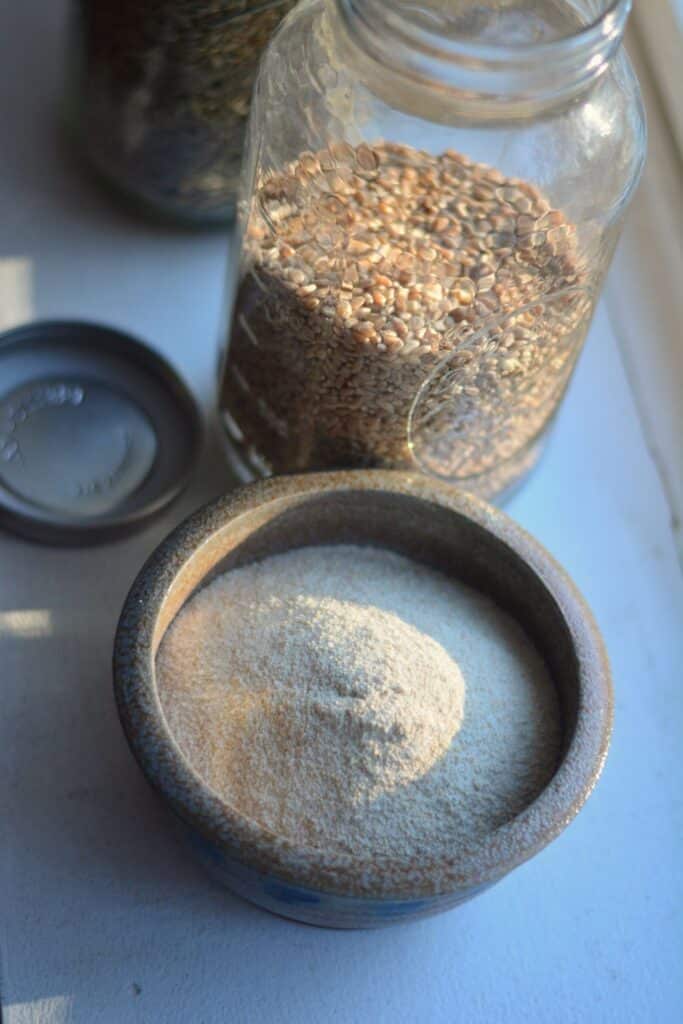
In a nutshell, these are the three mills I’ve personally used and recommend:
- The Classic Nutrimill does a great job, at the lowest price point.
- The Harvest Mill wins for most beautiful to sit on your counter.
- And the Mockmill is a beautiful workhorse that wins for best engineered, best at milling alternative grains, and the best at producing great flour, every time, but it also sits at the highest price point.
P.s. If you’re interested in a Nutrimill, code “SOULYRESTED” will save you cash!
More information about wheat berries and fresh milled flour:
- Why I started milling my own flour
- Tips for using fresh milled flour (with Lisa Bass)
- Fluffy 100% whole wheat dinner rolls with fresh flour (recipe)
- Kamut chocolate chip cookies (recipe)
- The ultimate guide to choosing a grain mill
Talk to me about Wheat Berries…
If you have questions, leave a comment below. And please tag me on ig to show me your wheat berries, how you store them, etc, @souly.rested.
“Whether you eat or drink, or whatever you do, do it all for the glory of God.” 1 Cor. 10:31
Pin this for later!
Click on the image below to pin this post.
Find out why SoulyRested was considered to be one of the One of the Top Homesteading Blogs.
Glance at my Resource Page if you’d like to get a glimpse of all the supplies I use and recommend for everything from gardening, to sugarmaking, to chicken care, to baking.
I’d love to connect!
To find me in some other neck of the woods, just click any (or every!) icon below:

